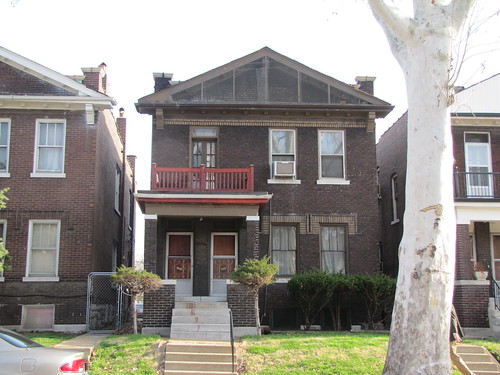While we were writing the building description of this two-flat in the proposed Fairground Park Historic District in the O’Fallon neighborhood, we did a double-take. Is that…? Yes, that is. An owner of this striking building at 4147 W. Kossuth Avenue, built in 1916 by contractor J.W. Jones, covered the open false gable end in mesh to keep birds out. The neighboring building to the west has an identical feature, open, and seems clean. the two buildings to the east have identical features closed-in. So it goes.
Category: O’Fallon
Today the St. Louis Preservation Board will consider recommending approval of the National Register of Historic Places nomination for the O’Fallon Park Historic District. This meeting is the first step toward listing the historic neighborhood in the National Register. After today, the nomination heads to the biggest step: consideration by the Missouri Advisory Council of Historic Preservation at its next public meeting on August 17.
View O’Fallon Park Historic District in a larger map
If the Advisory Council approves the nomination, it will be sent to the National Park Service for final listing. Depending on the length of that consideration, the O’Fallon Park Historic District might be listed in the National Register of Historic Places by the end of October. State and federal historic rehabilitation tax credits would be available immediately.
by Michael R. Allen
This blog continues to chronicle the loss of north St. Louis building stock. Our goal is to illuminate the repetitive impact of careless demolition policy, and the social impact of individual demolitions. There is a special problem posed by demolitions in neighborhoods that are proximate to parts of the north side that have retained architectural integrity and are already listed or eligible for listing in the National Register of Historic Places.
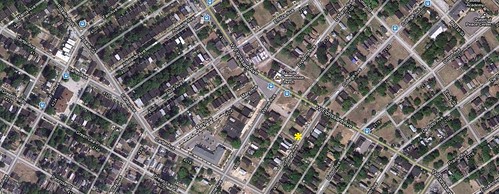
Demolitions across the north side don’t just remove problem properties. They remove housing stock and reduce the voter rolls. Demolitions destabilize neighborhoods. They erode sense of place, which turns owner-occupants away from neighborhoods, or north St. Louis entirely. Demolitions and persistent vacant lots lower land values. Expedient, perhaps. Damaging, for sure. The long-term impact of demolishing vacant buildings is the fulfillment of the “Team Four Plan” mythology: a depleted half-city easy to dismiss and lacking in density needed for truly flourishing urban life.
We are in the final stretch of the process of securing historic district status for most of the O’Fallon neighborhood. By early May, Preservation Research Office will have submitted the first of two National Register of Historic Places nominations that cover almost all of the historic neighborhood. The O’Fallon Park Historic District will encompass the areas east and south of O’Fallon Park, while the Fairground Park Historic District will encompass an area west of Fairgrounds Park south of Lee Avenue, north of Natural Bridge Avenue, west of Fair Avenue and east of Newstead Avenue.
The historic district designations are sponsored by the Acts Partnership with the assistance of Alderman Antonio D. French (D-21st). Work began last February on a 1,796-building survey that had led to the two historic district nominations currently being drafted.
The decision to split the neighborhood is based on subdivision history and development patterns. The area of O’Fallon west of Fairgrounds Park was first developed after the platting of White Place in 1859, but construction was slow. Additional subdivisions were Mary E. Burson’s Subdivision (1889), Fairground Place (1910), Lucille’s Fairground Park Addition (1912) and several others. Most of the building stock there dates to between 1910 and 1940, somewhat later than the northern part of O’Fallon that started development in the 1890s and largely built out by 1930. Like the northern part of the neighborhood, the area is remarkably intact. Here are a few photographs.

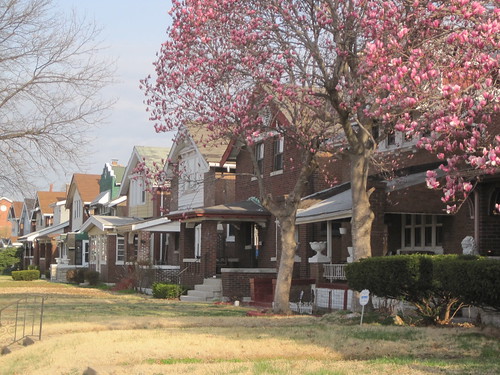
by Michael R. Allen
In the past few weeks, proponents of the possibly impending economic development deal crafted between leaders in the Missouri House and Senate have made excuses for proposed cuts to the historic rehabilitation tax credit: “it was going to be cut anyway.†This rationale has led many St. Louis political leaders, developers and even usually-opinionated bloggers to concede that the state’s proven revitalization tool will have to be lopped to make way for a brave new future of subsidies for new cargo warehouses.
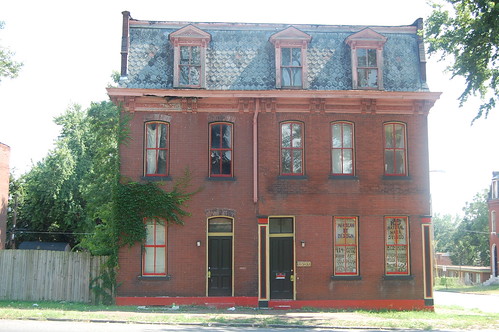
We’ve heard that the “big buildings are done,†a statement that one could not safely make at the corner of 8th and Olive streets in downtown St. Louis, or in the railyard industrial areas of Kansas City. We have hard that it’s time for “new money†and new economics, a line that fails to mention that the cargo warehouse credits as written would only go to new construction, and that warehouses are not know for either welcoming pedestrian flanks or for innovative architecture. Worst, we have heard that a $10 million limit on historic tax credit awards of $275,000 or less is somehow protection of neighborhood microdevelopment.
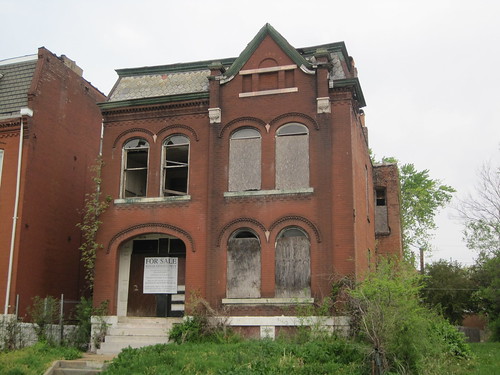
To be sure, having some nod toward small projects is better than none, but what we have on the table is an annual $90 million issuance of historic tax credits in which small projects will only get $10 million – not a penny more. The $80 million majority of credits will go to the big projects – the ones that some proponents have claimed are “mostly done.†This skewed ratio prevents small developers and property owners from direct competition with large development operations, but it represents a move to cut small projects to over half of activity we saw in Fiscal Year 2011.
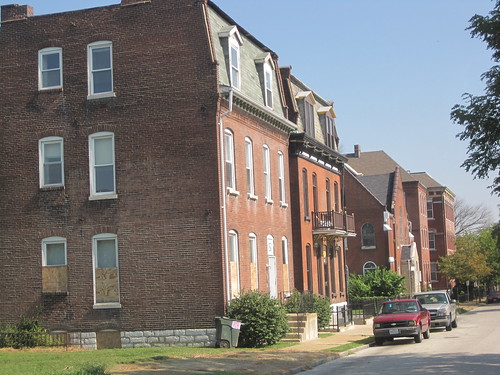
According to data from the Missouri department of Economic Development (DED), in Fiscal Year 2011, the state issued around $21.5 million in historic rehabilitation tax credits to projects that received $275,000 or less in tax credits. This activity represents 165 of the 385 projects to which DED issued historic tax credits. Of course, the total issuance was $116.2 million, so the small projects were far from the majority. Yet they account for around 43% of all projects that used the historic tax credit.
A formula based on caps of $10 million for small projects and $80 million for large projects will end up slowing the pace at which neighborhood revitalization can take place, in small towns and big cities. In St. Louis, the effects could be most harmful in distressed neighborhoods across north St. Louis where new historic districts are being created or have been created in St. Louis Place, the Ville, Penrose, O’Fallon and the Wellston Loop. Literally thousands of north St. Louis buildings will be eligible for the Missouri historic rehabilitation tax credit by the end of the next year, in addition to buildings in the rest of the city. Will these buildings have fair access to an incentive designed to bring them back to productive use?
The answer to that questions rests with the General Assembly, as well as to backers of the tax credits for the cargo warehouses. Those who advocate for neighborhood revitalization can fight for a mechanism that may bring us more jobs, which the region does need, but they should not let their guard down when it comes to the mechanism that often is what stands between a rehabilitated, human-scaled building and a vacant lot or gas station.
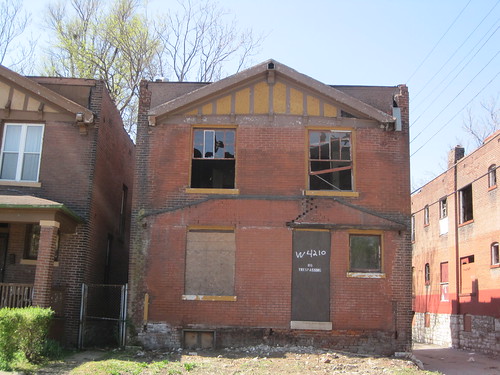
This is no either-or proposition – St. Louis will not be an attractive place for new investment if it neighborhoods aren’t improving. Missouri can’t give us unlimited money, but we can make sure that what we get doesn’t rob resources from neighborhoods that can’t afford lobbyists in the Capitol this week. A $10 million cap is too low. At least the cap should be based on last year’s activity of $21 million, so we don’t lose the momentum that is transforming tough blocks into great places to live.
by Christian Frommelt
My spring 2011 internship with the Preservation Research Office has allowed me to integrate academic interest with the simple desire to become a more dedicated member of the St. Louis community. Engaging with the type of work practiced by the PRO’s architectural historians has given me a rewarding experience not only in architectural history, but also in the deeper significance of historic preservation for the St. Louis community.

Since February 2011 I have primarily worked on building permit research, architectural photography, and building descriptions for the P.R.O.’s large-scale architectural survey of the O’Fallon neighborhood. As a result of this survey project the neighborhood will be recognized by the National Register as a Historic Place by this time next year. My latest contribution to the O’Fallon survey project involved collecting oral histories provided by North St. Louis residents, an aspect of the project that unified a study of the built environment, a deeper understanding of social issues such as demographic shifts in St. Louis, and one woman’s personal experience at the forefront of a transitioning neighborhood in North St. Louis.
Mabel Jones, an enthusiastic citizen of the Penrose neighborhood, was the first to participate in an interview. She outlined her decision to move at age twenty from Whiteville, Tennessee to St. Louis, where she began working in a laundromat and later on the Near North Riverfront’s Produce Row. As she described her marriage and the upbringing of her five children, Mabel highlighted her ability to gradually move from cramped kitchenette apartments west of Downtown St. Louis during the late 1940s and early 1950s, to a new Pruitt and Igoe housing project in 1957, and, a year later, to the type of family home she had always admired in the Penrose neighborhood. Mabel detailed the make-up of her block as it quickly transitioned from a primarily white to primarily black block, and recounted the struggles, and also the pride, associated with being the first black family on a block of respectable single-family houses.
While I am thankful for having gained the ability to identify hipped dormers, quoins, and belvederes, my interactions with PRO staff, residents we met on O’Fallon streets, and community-minded enthusiasts like Mabel Jones, are what transcended the trudge of busy work which so explicitly marks many undergraduate internship experiences. My relationship with other people in St. Louis is what brought out-of-book research to life. As I have learned, the success of local preservationists and architectural historians lies not solely in a knowledge of and passion for St. Louis’ built environment, but also a steadfast recognition of the humanness in preserving our cityscapes. The fabric of the city does not consist merely of the architecture we admire from a distance, but of the people who inhabit St. Louis’ buildings, businesses, parks, and streets we all too frequently bypass.
Christian Frommelt was one of PRO’s interns from January through May 2011. He is the author of the blog Mound City Stomp.
Ash Pit, Adelaide Avenue
by Michael R. Allen
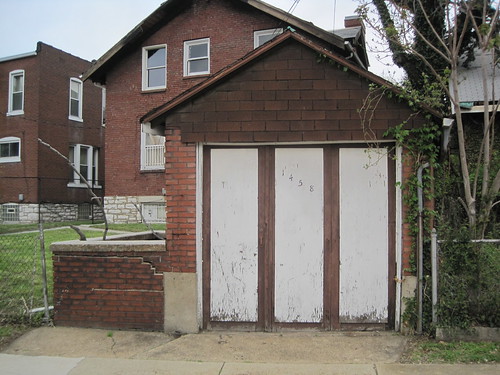
Amid our ongoing architectural survey of the city’s O’Fallon neighborhood, we came across an amazing ash pit adjacent to the garage behind the house at 1458 Adelaide Avenue. Due to the convergence of Adelaide and Warne avenues, the garage actually faces Warne across the street from the Mt. Grace Convent, better known as the home of the “Pink Sisters”.
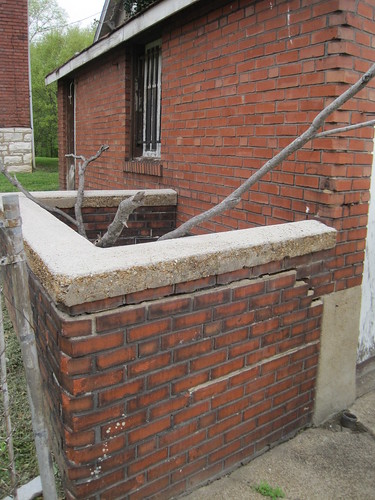
Ash pits were a common part of the residential landscapes of the 19th and early 20th century city. These boxes, sometimes open on the alley-facing or rear side, contained the ash created by residents’ burning their trash and cleaning their fireplaces of coal ash. Smoke regulations passed in 1940 by the Board of Aldermen essentially ended residential trash burning and the use of cheap, soft coal for household fuel. Thus, the ash pit was no longer used and many have disappeared from the city’s alleys. Some, like the one here, remain. This one is particularly well-built in red brick matching the garage as well as concrete coping. (A side note: Check out the neat corner bond on the garage itself; the rear wall follows the diagonal street, so the garage does not have square corners at Warne.)
by Michael R. Allen

When I first photographed these six vacant buildings in the 4200 block of Warne in the Fairground neighborhood in March 2005, I was struck by what a statement they made as a row. Besides the four-flat shown at left, the rest of the group consisted of St. Louis’ bread-and-butter building, the two-flat. The variety of styles in the group could very well have been a textbook illustration of St. Louis’ streetcar-fueled late 19th and early 20th century neighborhood development. Instead, in abandonment, the row served as a different, disturbing illustration.

By August 2009, the four-family building was demolished. An amazing apartment building across the street was also gone. The rest of the row was in bad shape, although each building was structurally sound. I confess to having low hopes for the group. Located in the city’s Third Ward, the five remaining buildings were owned by the Land Reutilization Authority and outside of any historic district. Had these buildings been inside of a historic district, they would have made a great historic tax credit project for a community development corporation.

In the last three weeks, the row has finally disappeared. These buildings were on the edge of Fairground, located across the street from the O’Fallon neighborhood. Their loss is felt strongest in the O’Fallon neighborhood, where a historic district nomination is underway, by dissolving a visual edge.
Around Green Lea Place
Late last week our team photographed in the eastern end of O’Fallon on Green Lea Place, Harris Avenue and Clay Avenue. This pocket of the neighborhood is in the Third Ward of the city,while the rest lies in the Twenty-First. As with much of the rest of the center of O’Fallon, the development here is marked by a diversity of forms, periods and materials. There is a notable concentration of frame buildings here. Harrison School at Fair and Green Lea Place, vacant and for sale after an aborted rehab effort, is an anchor.



Yesterday the Preservation Research Office staff spent the morning undertaking our second session of intensive photography for the neighborhood-wide architectural survey funded by Alderman Antonio French through The Acts Partnership. We are photographing each and every one of the neighborhood’s lovely buildings in order to prepare descriptions of each one needed for the National register of Historic Places historic district nomination we will submit this year.
Here are some of yesterday’s scenes.



